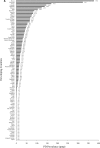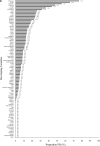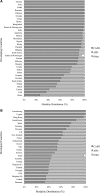Global trends in rates of peritoneal dialysis
- PMID: 22302194
- PMCID: PMC3294313
- DOI: 10.1681/ASN.2011060607
Global trends in rates of peritoneal dialysis
Abstract
Although there is a perception that the use of peritoneal dialysis is declining worldwide, compilations of global data are unavailable to test this hypothesis. We assessed longitudinal trends in the use of peritoneal dialysis from 1997 to 2008 in 130 countries. The preferred data sources were renal registries, followed by nephrology societies, health ministries, academic centers, national experts, and industry affiliates. In 2008, there were approximately 196,000 peritoneal dialysis patients worldwide, representing 11% of the dialysis population. In total, 59% were treated in developing countries and 41% in developed countries. Over 12 years, the number of peritoneal dialysis patients increased in developing countries by 24.9 patients per million population and in developed countries by 21.8 per million population. The proportion of all dialysis patients treated with peritoneal dialysis did not change in developing countries but significantly declined in developed countries by 5.3%. The use of automated peritoneal dialysis increased by 14.5% in developing countries and by 30.3% in developed countries. In summary, the number of patients treated with peritoneal dialysis rose worldwide from 1997 to 2008, with a 2.5-fold increase in the prevalence of peritoneal dialysis patients in developing countries. The proportion of all dialysis patients treated with this modality continues to decline in developed countries.
Figures









References
-
- Aviles-Gomez R, Luquin-Arellano VH, Garcia-Garcia G, Ibarra-Hernandez M, Briseño-Renteria G: Is renal replacement therapy for all possible in developing countries? Ethn Dis 16[Suppl 2]: S2–S70, 2, 2006 - PubMed
-
- Barsoum RS: Chronic kidney disease in the developing world. N Engl J Med 354: 997–999, 2006 - PubMed
-
- Kher V: End-stage renal disease in developing countries. Kidney Int 62: 350–362, 2002 - PubMed
Publication types
MeSH terms
Grants and funding
LinkOut - more resources
Full Text Sources
Other Literature Sources
Medical

